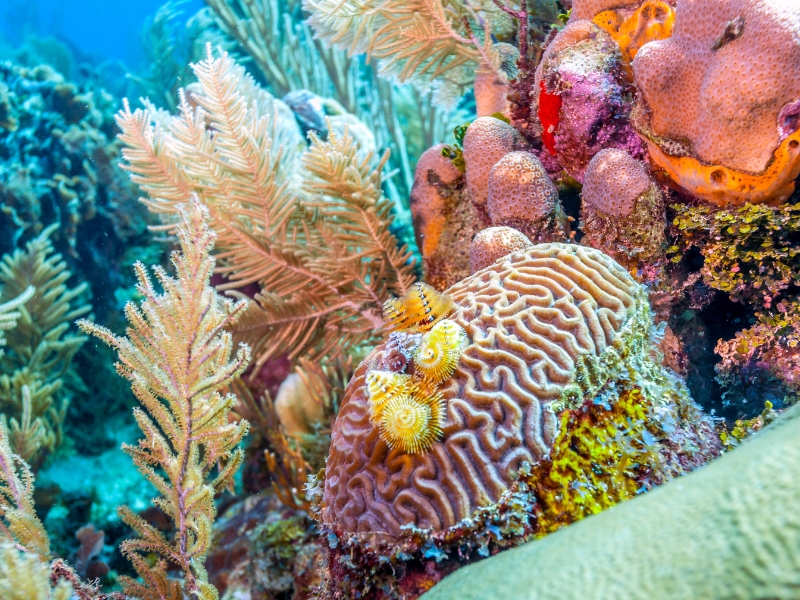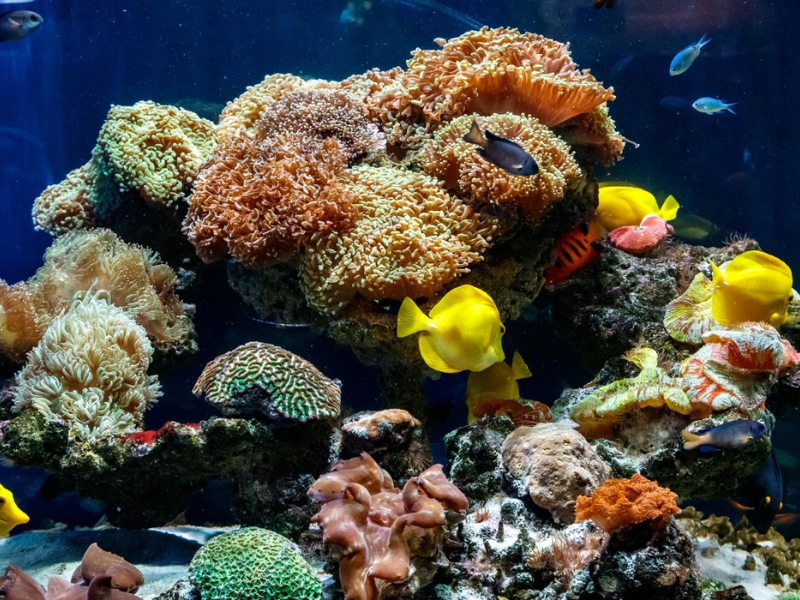Coral reefs, frequently referred to as the “rainforests of the sea,” are vital to the health of our planet.
Their importance cannot be emphasized, as they act as the first barrier against coastal storms while providing a habitat for various marine organisms.
Unfortunately, our vibrant and colorful underwater ecosystems are currently under severe threat.
What are Coral Reefs?
Coral reefs are unique underwater ecosystems made up of colonies of tiny animals known as coral polyps. Held together by calcium carbonate, these ecosystems are beautiful to behold and teeming with life.
Why are Coral Reefs Important?
Coral reefs are essential for several reasons. They provide habitat and shelter for various marine organisms, aid in nutrient recycling, and protect coastlines from the devastating impacts of wave action and tropical storms.
The Coral Ecosystem
Biodiversity is the cornerstone of coral reefs. With thousands of species living in these ecosystems, they are among Earth’s most diverse and valuable ecosystems. More than just being a marine spectacle, coral reefs play a crucial role in the environment, including nutrient cycling and carbon storage.
The Role of Coral Reefs in World’s Ecosystem
Natural Barrier
Coral reefs operate as a natural barrier, protecting coastlines from waves, storms, and flooding, hence reducing loss of life.
Nutrient Cycling
Coral reefs are critical components of the ocean’s nutrient cycling process. They’re involved in recycling nutrients such as nitrogen and phosphorus, essential for marine life.
Support for Human Life
Coral reefs are also indispensable for humans, providing food, tourism income, and even medicines.
The Three Main Types of Coral Reefs

Coral reefs are classified into three types: fringing, barrier, and atoll reefs.
Each reef type plays a unique role in the ecosystem and varies in size, location, and species diversity.
Fringing Reefs
Fringing reefs are the most prevalent type of coral reef, forming near the coastlines of islands and continents.
They are characterized by their shoreward growth, extending outwards and downwards from the land.
They are often separated from the beach by a shallow lagoon.
Furthermore, these reefs provide critical habitats for diverse marine life and operate as natural breakwaters, reducing coastal erosion.
Barrier Reefs
Barrier reefs are much larger and further away from the shoreline, separated by deeper, wider lagoons. The most well-known example of this type is Australia’s Great Barrier Reef.
They also grow parallel to shorelines but at a greater distance. They are separated from the landmass by a wide and deep lagoon.
Barrier reefs are biodiversity hotspots that offer a vital shield against oceanic waves, storms, and tsunamis.
Atoll Reefs
Atoll reefs are circular or oval-shaped reefs with a central lagoon. They are usually found in the middle of the sea and are often the result of a sunken island or volcano.
Thus, they form around a volcanic island that has subsided beneath the ocean surface.
Because of their isolated character, atolls are important in providing habitat for various marine organisms.
Coral bleaching – Will we be able to see coral reefs in the near future?
Coral bleaching is a phenomenon of color loss in corals. Bleaching not only makes corals appear pale, but it also has major consequences for their health.
Normally, corals are covered with zooxanthellae, microscopic algae. The algae live in a symbiotic relationship with the corals, supplying them with nourishment via photosynthesis.
However, high water temperatures and pollution make corals expel the algae from their tissues, which appears like bleaching. With no other source of coral supplements to provide them with nutrients, bleached organisms become highly susceptible to diseases.
According to the 2020 World’s Coral Reef Report, at least 14% of the world’s coral reef population was killed by bleaching.
Which coral reefs are most endangered?
Unfortunately, the Great Barrier Reef, the longest reef system in the world, is also one of the most endangered reefs since it lost 50% of its population to bleaching within a single year between 2016 and 2017.
The scale of the threat to Indonesia’s coral reefs is also staggering, with 95% of reefs at risk. Numerous coral reef systems in Maui, Hawaii, had lost up to 25% of their populations by 2006, and the number continues to increase.
In fact, all of the world’s coral reefs can be at risk at any time, as showed the case with the El Niño climate phenomenon, which brought warm surface waters to the eastern and central equatorial parts of the Pacific Ocean, affecting more than 70% of the coral population between 2014 and 2017.
Threats to Coral Reefs
Climate Change: This phenomenon represents a significant threat to coral reefs. Rising ocean temperatures lead to coral bleaching, a stress response that can result in coral death.
Overfishing and Destructive Fishing Practices: Overfishing, along with harmful fishing practices, can disturb the ecological balance of coral reef ecosystems.
Pollution: Pollution, especially from agricultural runoff and marine debris, can devastate coral reefs. Although coral reefs can suffer from natural processes such as storms, exposure to human-caused hazards is more dangerous. These include oil spills, pollutants, or agricultural fertilizers.
Coral reef preservation
Developing effective strategies to protect coral reefs will require multidisciplinary specialists and, in particular, the help of oceanographers as they provide real-time data and document bleaching histories, assess the adaptive capacity of corals and reef animals to temperature increases, and develop plans for intervention.
While mitigating climate change, adopting sustainable fishing practices, controlling pollution, and expanding marine protected areas are some of the approaches that can help address the causes of coral bleaching, the repopulation of coral reef ecosystems cannot be underestimated.
Dedicated coral reef supplements and other products for marine ecosystems from Aquaforest, such as reef salt, water tests, high-quality strontium, and barium help maintain the health of corals in home aquariums, as well as in zoos, oceanariums, professional breeding and research facilities, which is key to coral propagation and restoration.
Impacts of Coral Reef Degradation
The degradation of coral reefs has far-reaching consequences. It not only disrupts the rich biodiversity living in these reefs but also affects human societies. For example, coastal communities heavily depend on these ecosystems for food, protection against storms, and tourism income.
Efforts to Save Coral Reefs
The challenges are substantial, but so are the efforts to overcome them.
Coral restoration and conservation projects are being initiated worldwide, involving everything from coral farming to implementing marine protected areas.
Additionally, international policies increasingly acknowledge the importance of protecting these crucial ecosystems.
Last Words on Coral Reefs in Danger
Saving our coral reefs will require worldwide cooperation. Small measures, such as lowering carbon footprints and supporting sustainable seafood, can make a big difference.
By protecting these precious ecosystems, we are preserving not only marine life but also the well-being of future human generations.
FAQs
What is the largest type of coral reef?
The largest type of coral reef is the Barrier Reef, with the Great Barrier Reef being the largest.
Why are coral reefs often called the “rainforests of the sea”?
Coral reefs are regarded as the “rainforests of the sea” because of their incredible biodiversity.
Like rainforests, they host an enormous variety of species within a relatively small area.
What causes coral bleaching?
Coral bleaching is primarily caused by the warming of ocean temperatures due to climate change.
Corals expel the algae dwelling in their tissues when the water becomes too warm, causing the coral to turn entirely white.
How do coral reefs benefit the economy?
Coral reefs significantly contribute to local economies through fisheries and tourism. They also provide numerous ecosystem services, including shoreline protection.
How does climate change affect coral reefs?
Climate change leads to increased ocean temperatures and acidity, which causes coral bleaching and can lead to the death of coral colonies.
What can I do to help protect coral reefs?
Individual actions can significantly contribute to coral reef protection. These can include reducing water use, avoiding harmful fishing practices, supporting reef-friendly businesses, and advocating for policies that protect reefs.
How do corals reproduce?
Corals can reproduce both sexually and asexually. In sexual reproduction, corals release eggs and sperm into the water. In asexual reproduction, a new coral polyp grows from a parent polyp.

